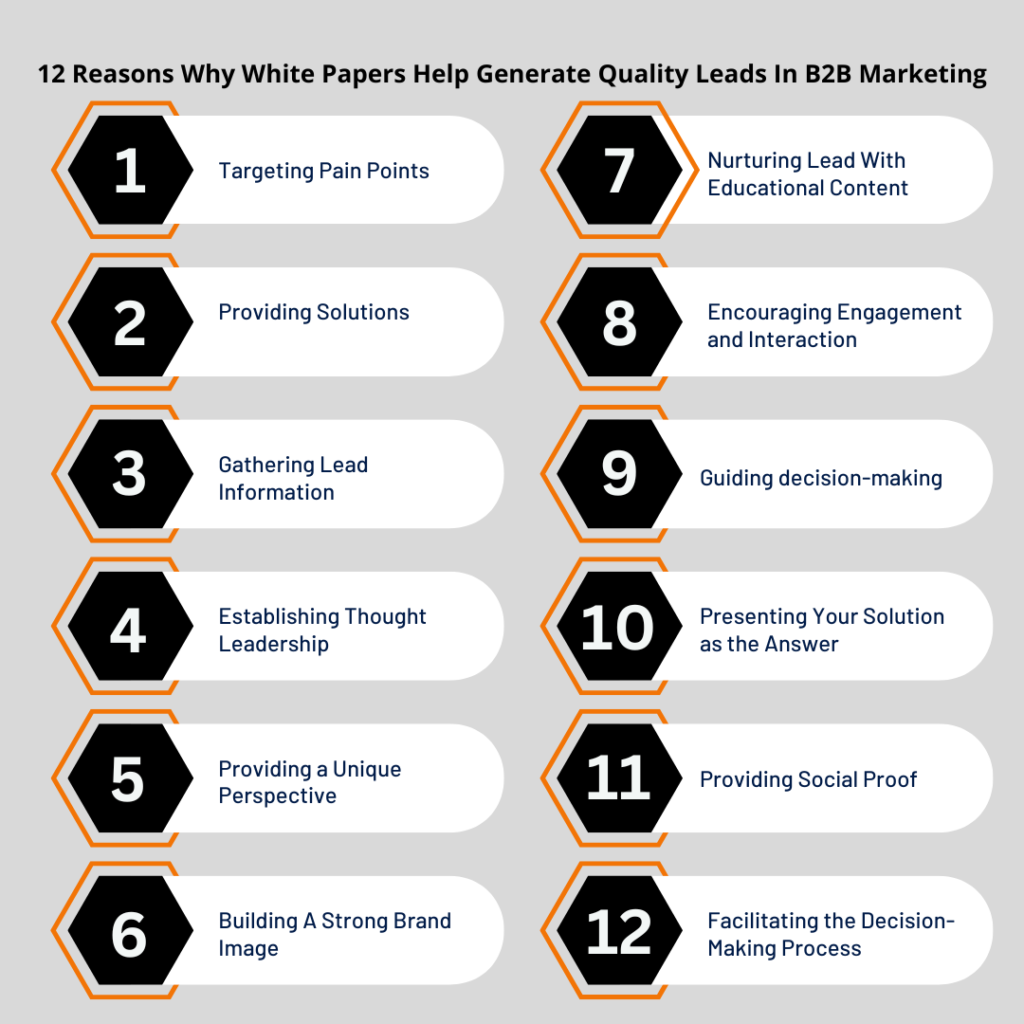
Why White Papers in B2B Marketing are Your Lead Magnets
- Last updated on: February 16, 2024
One of the best ways to establish yourself as a thought leader in your industry is by compiling well-researched white papers – an excellent source of information for your audience. If your White Papers in B2B Marketing has some novel data or promises to provide a solution to an industry-recognized problem, then you don’t even have to start with the sales pitch.
Your audience will voluntarily enroll themselves in your lead list. Such is the power of white papers which is why they are used as powerful tools in B2B marketing. Whether you’re dealing with a SaaS product, a blockchain ICO, or any other technical offering, white papers play a crucial role in raising awareness and addressing potential prospects’ inquiries or alleviating their concerns.
According to research published by Longitude, 62% of C-suite decision-makers request calls or meetings with companies that produce high-quality thought leadership content. 8 in 10 of those will happily provide their contact details to download in-depth reports.
If you’re looking to target higher-quality leads, a white paper is an excellent place to start. Utilizing White papers in B2B Marketing is an incredible strategy for promoting your product or brand. Let us now understand the various ways in which white papers can draw high-quality leads.
12 Reasons Why White Papers Help Generate Quality Leads In B2B Marketing

1.Targeting Pain Points
By addressing genuine industry concerns and offering valuable information, white papers attract potential B2B customers genuinely interested in a topic. A well-crafted white paper starts by outlining specific challenges faced by your target audience within your industry. It attempts to dig deeper into the core problem area by exploring the complexities and nuances of the subject matter.
This resonates with individuals actively seeking solutions, attracting those genuinely interested in what you offer. When you offer genuine data in your white paper, it also represents your company’s knowledge and expertise in addressing the problem.
2.Providing Solutions
Use a white paper to present a solution, methodology, or framework for a problem. This shows your skills as a problem-solver. Clearly outline the benefits of your solution. This can subtly guide readers to see your offerings as valuable options.
3.Gathering Lead Information
Often, white papers are gated, requiring users to submit contact information in exchange for access. This makes white papers an excellent B2B marketing technique to acquire leads who are genuinely interested in the content and likely qualified prospects.
Ask specific questions during the gating process. Gather information to qualify leads based on their needs and industry fit. This ensures higher conversion rates.
4.Establishing Thought Leadership
White papers are crucial in B2B marketing for establishing thought leadership. They showcase your expertise and authority in a specific area. Unlike shorter content, white papers delve deeply into complex topics. They provide detailed analysis, demonstrating your comprehensive understanding.
Integrating original research, data analysis, and case studies strengthens your arguments and provides unique insights beyond readily available information. Citing credible sources and experts bolsters your credibility and positions your work within the broader context of the industry.
5.Providing a Unique Perspective
Marketing white papers can challenge existing assumptions and propose novel solutions, showcasing your innovative thinking and ability to tackle industry challenges differently. Presenting well-structured frameworks or methodologies positions you as a thought leader capable of providing practical and implementable solutions.
Backing up your claims with solid evidence, data, and research solidifies your credibility and makes your recommendations more persuasive.
6.Building A Strong Brand Image
Ensuring consistency between the white paper and your overall brand messaging reinforces your identity and strengthens brand recognition. White papers establish thought leadership by showcasing your deep understanding, offering unique perspectives, presenting well-researched solutions, and effectively communicating your expertise to a relevant audience.
This builds trust and positions you as a valuable resource within your industry.
7.Nurturing Lead With Educational Content
A white paper nurtures potential customers, or leads, with educational content in several ways. Unlike shorter pieces, white papers provide a more structured and comprehensive learning experience, guiding readers through a logical flow of information, and building their understanding step-by-step.
Integrating text, visuals, data, and even multimedia elements caters to different learning styles and preferences, enhancing engagement and knowledge retention. While delivering valuable information, white papers in B2B marketing go beyond mere education by offering practical takeaways, tips, and actionable insights applicable to real-world scenarios.
8.Encouraging Engagement and Interaction
Including thought-provoking questions and discussion points within the white paper encourages deeper engagement and prompts to explore the topic further. Implementing a clear and relevant CTA (e.g., download additional resources, contact sales) guides leads toward the next step in their buyer’s journey.
Sharing the white paper and engaging in discussions on relevant social media channels and online communities fosters interaction and allows you to address reader questions directly.
9.Guiding decision-making
A white paper can subtly but effectively guide decision-making in B2B scenarios through several key strategies. By effectively highlighting the negative consequences and impact of the problem your target audience faces, the white paper creates a sense of urgency and motivates them to seek solutions.
Presenting data and statistics that showcase the financial or operational losses associated with the problem further underlines its importance and prompts decision-makers to consider solutions.
10.Presenting Your Solution as the Answer
The white paper clearly explains your approach, emphasizing its features and benefits in a straightforward manner. This allows for easy comparison with other options. Highlighting positive outcomes and improvements through your solution, backed by data and case studies, creates a compelling value proposition. Marketing white papers can subtly point out the limitations or drawbacks of alternative solutions, further showcasing your own strengths, without direct negativity.
11.Providing Social Proof
Featuring positive feedback from existing clients who have benefited from your solution provides social proof and reinforces the benefits you offer. Highlighting your commitment to client satisfaction through guarantees, warranties, and ongoing support instills confidence in decision-makers.
12.Facilitating the Decision-Making Process
The white paper concludes with a call to action (CTA) that guides decision-makers toward the next step in their journey, such as a consultation, demo, or free trial. Providing access to further white papers, case studies, or webinars deepens their understanding and empowers them to make informed decisions.
Encouraging readers to contact your sales team or engage in discussions around the white paper allows you to address specific concerns and tailor your solution to their unique needs.
Key takeaways:
White papers in B2B marketing are an excellent tool to attract high-quality leads. This is because white papers help:
- Target pain points & offer solutions (gated for qualified leads).
- Establish thought leadership with unique perspectives & data-backed claims.
- Build brand image & nurture leads with educational content & actionable insights.
- Encourage engagement & guide decision-making with CTAs & social proof.
- Facilitate the next steps with further resources & sales interaction.
While white papers excel at transforming complex information, boosting SEO, showcasing thought leadership, and eventually, attracting the right leads, their true power lies in building deeper connections with your audience. They inform, engage, and nurture leads, ultimately fostering trust and a lasting bond that transcends mere business transactions.




